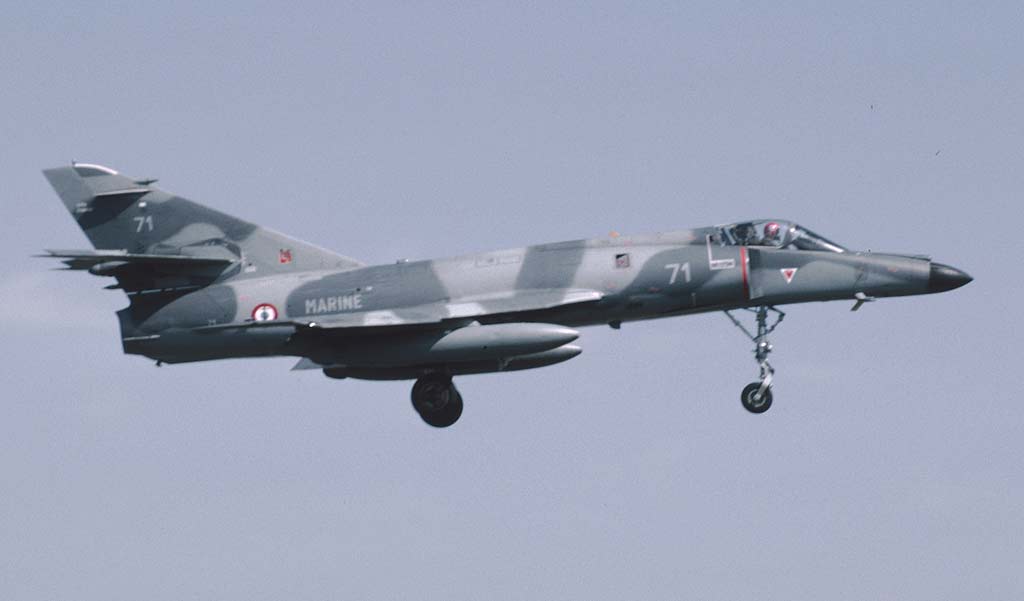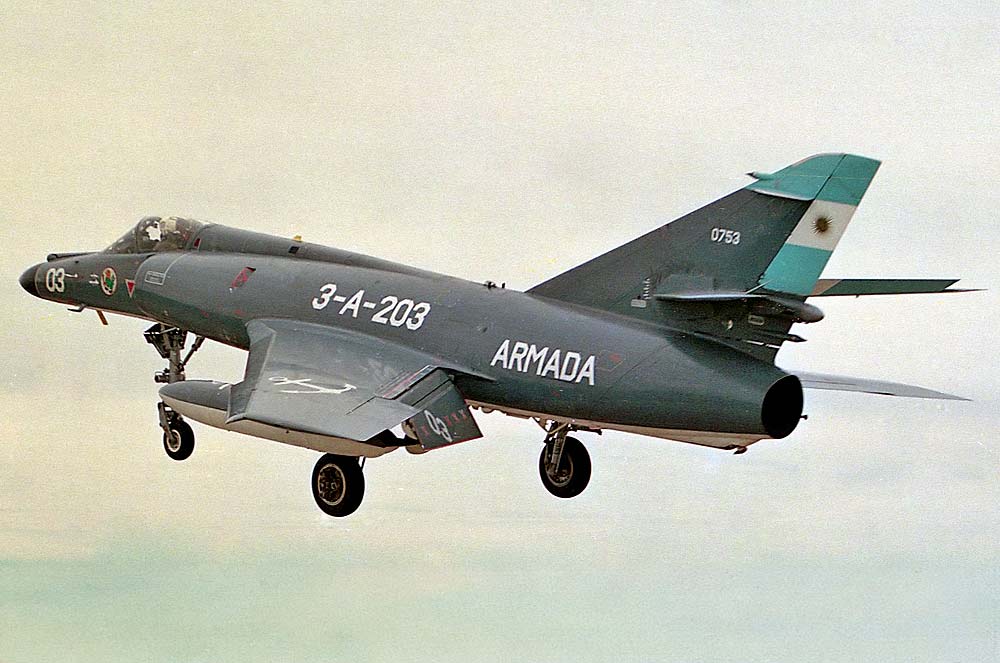French carrier-capable strike fighter, excels in precision attack roles.
In brief
The Dassault Super Étendard is a French naval strike aircraft developed and manufactured by Dassault Aviation. It entered service in 1978, designed primarily for carrier-based operations. The aircraft is powered by a single Snecma Atar 8K50 turbojet engine, producing 49.03 kN of thrust, enabling a top speed of over 735 miles per hour. It has a range of approximately 1,000 miles and can operate at a ceiling of up to 45,000 feet. The Super Étendard is equipped for various roles, including ground attack, anti-ship, and reconnaissance, and can carry an array of weaponry such as laser-guided bombs, anti-ship missiles, and a built-in 30mm cannon.

History of the Development of the Dassault Super Étendard
In the early 1970s, the French Navy sought to modernize its fleet air arm with an advanced, versatile strike aircraft capable of precise delivery of conventional and nuclear weapons. The need was partly driven by the evolving geopolitical landscape marked by Cold War tensions and the growing importance of naval power projection. Dassault Aviation, building on the success and framework of the earlier Étendard IV, initiated the development of what would become the Super Étendard.
Officially launched by the French government in 1973, the program aimed to produce an aircraft that could perform multiple roles from carrier platforms, ensuring compatibility with existing fleet operations while introducing new technologies and capabilities. The Super Étendard first flew on October 28, 1974, showcasing promising performance and advanced systems integration from the outset.
Unlike many of its contemporaries, the Super Étendard was designed without a specific NATO reporting name, reflecting its primary deployment within the French Navy and limited export footprint during its early years. The aircraft was a response to the specific operational requirements of the French military, incorporating significant advancements in avionics and weapon systems that would allow France to maintain a technological edge in naval aviation.
The development period was marked by a focus on enhancing the airframe’s aerodynamics, improving engine performance, and integrating new electronic warfare and targeting systems. These improvements were vital for the roles envisioned for the Super Étendard, including deterrence patrols, deep strike missions, and maritime interdiction.
Design of the Dassault Super Étendard
The design of the Super Étendard incorporated several key features tailored to the needs of naval operations. Measuring 14.31 meters in length with a wingspan of 9.60 meters, the aircraft’s compact dimensions were ideal for carrier operations. The airframe was built primarily from light alloys, offering a balance between structural integrity and weight, crucial for an aircraft that needed to operate efficiently from the constrained space of an aircraft carrier.
Powered by the Snecma Atar 8K50 turbojet engine, the Super Étendard was capable of reaching speeds up to Mach 1.3. The engine’s design focused on reliability and maintainability, essential for operations where technical support might be limited. One of the most significant design choices was the integration of the Thomson-CSF Agave radar, which enabled the deployment of the Exocet anti-ship missile—a capability that significantly expanded the operational roles of the aircraft.
However, the reliance on a single engine, while beneficial for weight and maintenance, posed a risk of failure that could leave the pilot and aircraft vulnerable. Furthermore, the aircraft’s performance was constrained by its engine’s power output, particularly in fully loaded configurations. Despite these drawbacks, the Super Étendard’s design provided a good balance of speed, agility, and payload capacity, making it a formidable asset in naval warfare.
Performance of the Dassault Super Étendard
The Super Étendard’s performance is characterized by its robust engine and well-designed airframe. With a top speed of over 735 miles per hour (1,182 kilometers per hour) and a maximum takeoff weight of 12,000 kilograms, the aircraft could carry a significant payload over considerable distances. Its operational range of about 1,000 miles (1,852 kilometers) and service ceiling of 45,000 feet (13,716 meters) made it versatile in a range of mission profiles.
When compared to its contemporaries like the American A-4 Skyhawk, the Super Étendard offered superior avionics and weapon integration, although it generally fell short of the larger, more powerful American A-7 Corsair II in terms of payload capacity and range. However, its ability to deploy the Exocet missile gave it a particular edge in anti-ship roles, a capability that proved decisive in several conflict scenarios.
Variants of the Dassault Super Étendard
The Super Étendard saw several variants over its service life, including the initial production model and the later Super Étendard Modernisé (SEM), which featured upgraded avionics, improved radar systems, and compatibility with more advanced weaponry, including laser-guided bombs. The SEM variant extended the operational life of the aircraft significantly, providing enhanced capabilities that kept the platform relevant even as newer technologies emerged.

Military Use and Combat of the Dassault Super Étendard
The Super Étendard first saw combat in the 1980s during the Falklands War, where Argentine Navy pilots used the aircraft to launch successful Exocet missile attacks against British ships. These missions underscored the aircraft’s effectiveness in anti-ship roles and demonstrated the strategic value of advanced avionics and weapon systems in modern naval warfare. The aircraft continued to see action in various conflicts, serving with both the French Navy and the Argentine Navy.
The armament of the Super Étendard, including its 30mm DEFA cannon, Exocet missiles, and a variety of bombs and rockets, made it highly effective in a wide range of military operations. Its versatility and powerful strike capabilities were demonstrated in numerous missions, from direct combat engagements to targeted strike operations.
The Super Étendard was eventually phased out by the French Navy in favor of more modern aircraft like the Dassault Rafale M, which offered enhanced multirole capabilities, stealth features, and greater payload capacity. However, the aircraft remains in service with other countries, continuing to provide reliable service.
The Dassault Super Étendard has been a key component of French naval power, demonstrating significant capabilities in precision strike, reconnaissance, and fleet defense roles. Its development and operational history reflect its importance in modern naval aviation, offering a blend of reliability, power, and advanced technology that made it a critical asset in numerous military engagements around the world.
Back to the Fighter Jet section.